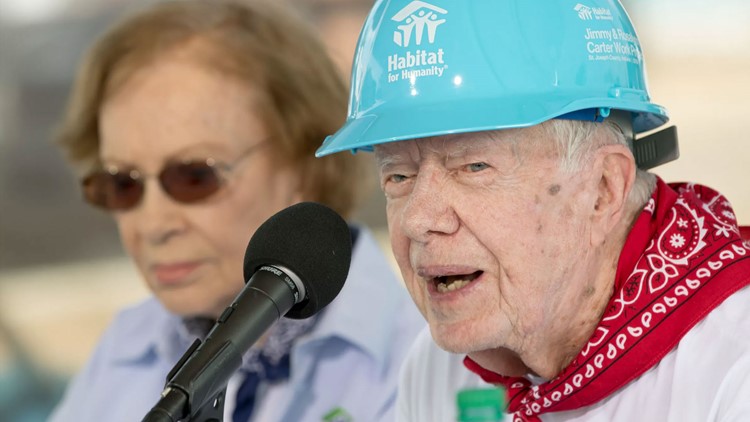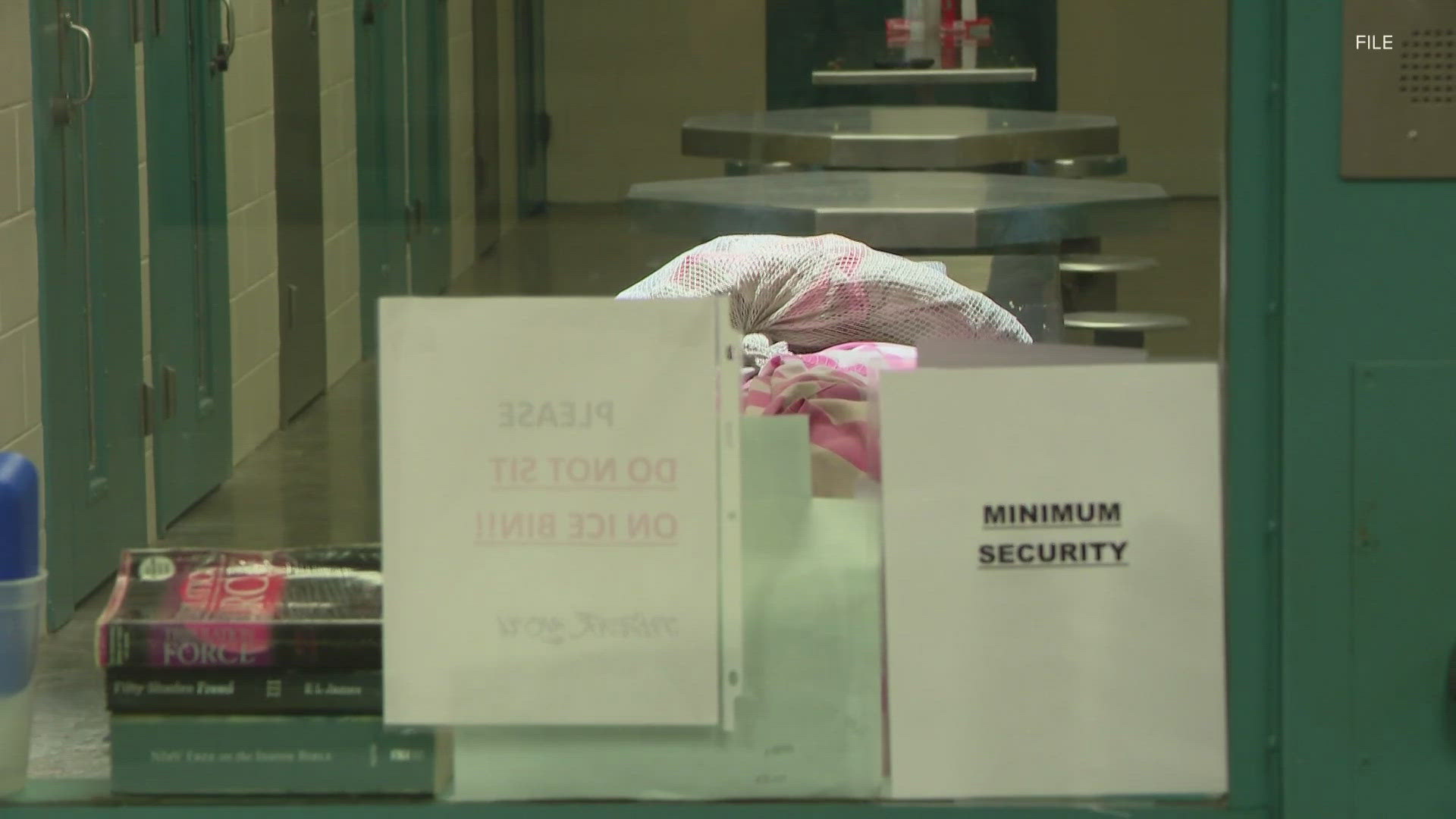(INDYSTAR.com) - Over the years, Ericka Santiesteban has watched with envy — and a hint of sadness — as friends and family used pencil marks to track their children's growth on the walls of their homes.
It's a common ritual, but for this Hoosier mother of three boys, ages 13, 12 and 3, an elusive one. Elusive because they've never had their own home. Or their own walls.
That's about to change — thanks, in large part, to a former U.S. president and a cadre of hammer-wielding volunteers that included the likes of David Letterman, Garth Brooks and Trisha Yearwood.
This year, for the first time, Indiana was chosen as the location for Habitat for Humanity's annual Carter Work Project. Since 1984, President Jimmy Carter and his wife, Rosalynn, have partnered with Habitat for Humanity to build, repair or renovate nearly 4,300 homes for people in need across the globe.
This year, they descended upon Mishawaka to build most of a 23-home subdivision in five days.
One of those homes — known to volunteers simply as Home No. 5 — will soon belong to Santiesteban.
Tears crept down the 28-year-old's cheeks as she explained how she has longed to give her boys a place to call their own, filled with the kind of memories they can’t pack into moving boxes.
“Now my kids will have that, and we’ll have that forever,” Santiesteban said. “And we won’t have to leave it again.”
It also means she will finally fulfill that long-awaited loving task.
“The first thing we’re going to do," Santiesteban said, "is measure ourselves on a wall.”
Carter Work Project changes lives
The Carters were $1 million in debt when they left the White House in 1981, but they were eager to give back.
“We wanted to do something nice for poor people, but it’s very difficult for anybody ... to break down the barrier that exists between well-off people and very poor people,” President Carter said at a Monday news conference. “It’s kind of an impenetrable barrier between the two.”
Carter, who grew up in a Plains, Georgia, farmhouse without water and electricity, said he knows the impact a decent home can have on a family.
“It transformed our lives, literally, to a better life when we got water in the house to start with,” he said. “And then after, when we got electricity, it just transformed everything.”
The Carter Work Project has taken more than 100,000 volunteers to worksites in countries including Canada, Haiti, Thailand, India and throughout the U.S. since 1984. With projects planned throughout the year, the Carter Work Project will build, renovate or repair 41 homes in South Bend and Mishawaka.
Nearly 17 percent of people in St. Joseph County live in poverty, according to Habitat. Forty percent of renters in the county — nearly 14,500 people — are “rent overburdened,” paying more than 30 percent of their gross income to housing.
Infrastructure work on the Mishawaka subdivision began last August on nine acres of donated land. The project’s $4.7 million budget covered the cost of the infrastructure as well as the homes, and Habitat chapters across the state pitched in a total of $325,000 to help fund construction.
Both over 90, the former president and his wife continue to build.
“We’re very grateful for the chance to come and work with Habitat. We hope that we continue to do it as long as we’re physically able, which may not be very long,” he said, flashing a wry smile. “But, anyway, we’re gonna do the best we can.”
The work doesn’t stop here.
The St. Joseph County chapter recently signed a purchase agreement with the owner to buy the neighboring seven acres for only $70,000, a move that will allow them to gradually double the size of the subdivision, said Jim Williams, president and CEO of the St. Joseph County Habitat chapter.
“We want obviously to keep the momentum going, we want to keep our citizens engaged,” Williams said, “and we want really this to just be the start.”
'A mark on history'
President Carter, wearing a red bandanna around his neck and a tool belt around his waist, kept busy outside House No. 6 as the metallic zing of saws sliced through thunderous hammering.
Carter, whose post-presidency has typically received more praise than his one term in the White House, remains active in politics and public service. A recipient of the 2002 Nobel Peace Prize, his namesake organization, the Carter Center, combats preventable diseases and works for peace across the globe.
Monday morning, he sat down for an interview with CBS This Morning‘s John Dickerson to discuss the life and legacy of the late Arizona Sen. John McCain.
Within just a few hours, he also helped volunteers raise a wall of Cleora Taylor’s future home.
Taylor, 36, said Carter’s work is a gift she and her four children will not take for granted.
“It’s like putting a mark on history for my babies,” Taylor said.
Taylor said the family is living with her grandmother until they can settle into their new home. Surveying the scale of the project, Taylor said it’s beyond anything she could have expected.
“I knew it was a big thing,” she said. “I just didn’t know how big.”
A few houses down, Benito and Jhunixa Salazar will finally have space for their family to grow. The couple spent years shuffling between one- and two-bedroom apartments priced at nearly $800 per month with annual increases.
Benito has two jobs and Jhunixa works part-time while homeschooling and caring for their children, a boy and a girl ages 2 and 4, but the traditional path to homeownership would have been rocky. Through Habitat, they’ve been able to learn about budgeting and financial security.
“Sometimes the credit scores might not be the best, sometimes we’re making it,” Jhunixa said. “But if we were to buy a house the regular way, then it would be a little hard on us.”
At their home and others across the U-shaped neighborhood, flags representing volunteers’ home states and countries flew, a reminder of the “great love” the homeowners are being shown, Benito said.
“They may not even be from this city, they’re from different cities, different states, different countries,” Benito said. “We’re worldly neighbors right now.”
'Who doesn’t want to be a part of that family?’
Over the course of the week, 2,000 volunteers will pass through the growing neighborhood, including several famous faces.
On Monday, country music stars Brooks and Yearwood worked on neighboring houses and Indianapolis native Letterman lent a hand at a home down the street.
Brooks and Yearwood, who began working with Habitat in New Orleans in the aftermath of Hurricane Katrina, are recognized as Habitat Humanitarians, along with the Carters.
Brooks briefly left the construction site Monday to hold a press conference announcing an October concert at Notre Dame, where he said the build was deepening his bond with the surrounding area.
“If you talk about Notre Dame, for me, the first word that comes up is community. And that right there, people, that’s another word for church; that’s having people there for you if you need them,” he said. “And who doesn’t want to be a part of that family?”
Williams said celebrities such as Brooks draw attention to the project, but the week is primarily about the families.
“This just gives us a wider and a bigger platform to tell the world that affordable housing does matter — it is an important issue — and that Habitat does have a way for people to become homeowners that really works," he said, "and that every family deserves a chance to build a better life for themselves.”
St. Joseph County marks the 15th Carter build for Rob Collett of Coconut Creek, Florida. As a gift to the homeowner, Collett brings pink lawn flamingos to every build and has volunteers sign them.
“For the life of me, I can’t explain (why I volunteer),” he said. “I just love doing it. It just makes me feel good. Maybe it’s because I'm selfish; there’s something I want to do for myself. But you touch so many people when you come to these sites.”
In 2011, the Carter Work Project built 100 homes near Léogâne, Haiti, the epicenter of the 2010 earthquake that ravaged the Caribbean nation. That week, Collett met Mapha, a woman who he helped build a new earthquake- and hurricane-proofed home.
When he returned with the Carter Work Project the next year, he made his way back to Mapha’s neighborhood.
“I was walking down the street and I turned the corner, and there she was in her Sunday best,” he said. “She had the best dress she owned, her makeup was done, her hair was done. We hugged each other and cried like babies.”
And on the mantle inside her immaculately kept home, Collett said, sat the pink flamingo.
“Her nephew, who interpreted, said, ‘She looks at that flamingo every day,’” Collett remembered. “’She knew you were coming back.’”
'Once in a lifetime'
An hour before sunrise on Tuesday, Santiesteban’s smile lit up the lawn.
After spending Monday building her home alongside Habitat volunteers, Santiesteban couldn't get off work. So, instead of constructing, she spent Tuesday morning cheering, planning to leave for the office before work resumed.
"I'm here every morning, just to at least be here, because I want to be a part of it,” she said.
The brown mulch path leading into the worksite was lined with volunteers and homeowners shaking green and blue pom-poms, welcoming workers as they emerged from vehicles and ambled to a nearby tent and a potato hash breakfast.
Plenty of water was encouraged — Monday’s heat index reached nearly 100 degrees. Sunscreen and lip balm were made available to protect workers from the blistering sun, and leaders lectured on the importance of balancing water, Gatorade and rest.
As the workers prepared for another day, Santiesteban was preparing for life’s next chapter. She’s taken Habitat's required financial literacy and home maintenance classes. For the first time, she’s ready to settle into a more stable environment she can call her own.
“It has set me up for success all the way through, for life,” she said. “... Now I’ll be able to teach my own kids these things so that way they don’t make all the mistakes I did.”
In just one day, her home went from being an empty foundation to having walls and a roof.
“It’s like magic,” Santiesteban said.
And constructing the home herself — with plenty of help — made the experience even more meaningful.
“It’s an experience that you get once in a lifetime,” Santiesteban said, “and I got lucky.”
Call IndyStar reporter Holly Hays at 317-444-6156. Follow her on Twitter: @hollyvhays.



